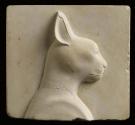Advanced Search
Double-sided votive relief
Egyptian
Hellenistic Period (Ptolemaic Dynasty)
305–30 B.C.
Medium/Technique
Limestone
Dimensions
Height x width x length: 20.5 x 22.2 x 1.1 cm (8 1/16 x 8 3/4 x 7/16 in.)
Credit Line
Helen and Alice Colburn Fund, Martha A. Willcomb Fund, and Museum purchase with funds donated by Mrs. Charles Gaston Smith's Group
Accession Number51.2474
NOT ON VIEW
CollectionsAncient Egypt, Nubia and the Near East
ClassificationsSculpture
DescriptionAlthough hundreds of relief plaques have survived from the Ptolemaic Dynasty, few are as fine and interesting as this one, decorated on both sides. The modeling of the cat is unusually bold and almost three-dimensional. Although it is widely regarded as the most Egyptian of animals, the sacred cat was a fairly late development in Egyptian religion, beginning about 1000 B.C., when the female of the species was identified with the goddess Bastet (formerly a lioness). She is ornamented with a necklace of cowrie shells, symbols of fertility, and a pendant in the form of the eye of Horus.
The ram-headed deity on the other side may be Khnum, the creator god that formed humankind from Nile clay, Harsaphes, or any of a number of Egyptian ram-gods all represented in the same fashion. He has a triangular depression beneath the chin meant to receive an inlay for a divine beard, and two pairs of long, upward-curving, corkscrew horns. The horns are those of a species that died out in Egypt during the Middle Kingdom (Ovis longipes paleoaegypticus), but they were retained as a symbol of divinity. These corkscrew horns appear to be unfinished. For this reason, plaques like this are often called trial pieces or sculptor’s models, but they are more likely to have been votive offerings in honor of the king or a god.
The ram-headed deity on the other side may be Khnum, the creator god that formed humankind from Nile clay, Harsaphes, or any of a number of Egyptian ram-gods all represented in the same fashion. He has a triangular depression beneath the chin meant to receive an inlay for a divine beard, and two pairs of long, upward-curving, corkscrew horns. The horns are those of a species that died out in Egypt during the Middle Kingdom (Ovis longipes paleoaegypticus), but they were retained as a symbol of divinity. These corkscrew horns appear to be unfinished. For this reason, plaques like this are often called trial pieces or sculptor’s models, but they are more likely to have been votive offerings in honor of the king or a god.
ProvenanceBy 1951: Charles L. Morley collection, NY; 1951: purchased by the MFA from Charles L. Morley for $2400.
(Accession Date: November 8, 1951)
(Accession Date: November 8, 1951)



